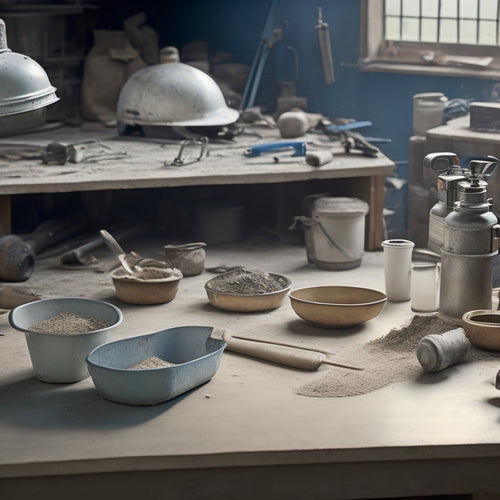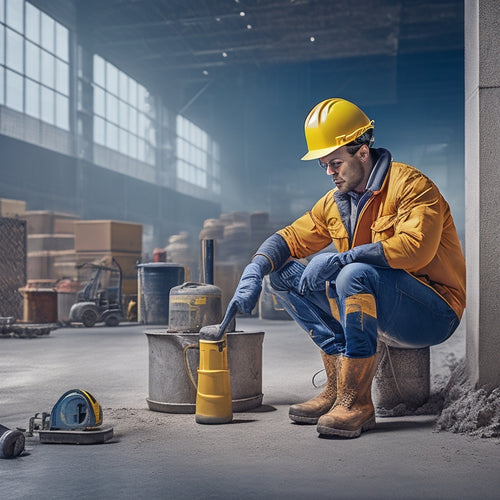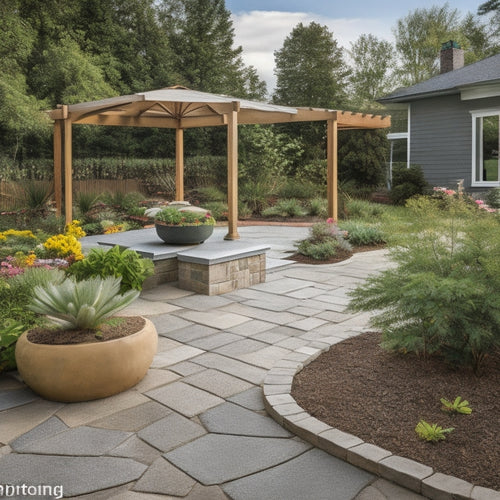
10 Must-Have Tools for Small Concrete Projects
Share
When tackling small concrete projects, you'll need a range of essential tools to achieve professional-grade results. For mixing, invest in a reliable concrete mixer, mixing bucket, and mixing tools, considering factors like capacity and equipment maintenance. For finishing touches, edging and jointing tools, smoothing and polishing tools, and texturing tools will help you create a flawless surface. Power trowels, concrete screeds, compaction tools, finishing blades, curing compound applicators, and safety gear are also must-haves. With these tools in your arsenal, you'll be well-equipped to tackle even the most complex small concrete projects - and by exploring each tool in more detail, you'll reveal the secrets to achieving truly exceptional results.
Key Takeaways
• A reliable concrete mixer is essential for mixing high-quality concrete, and choosing the right capacity is crucial for small projects.
• Hand tools like edgers, trowels, and floats are necessary for achieving a smooth, professional finish and adding textures or patterns.
• Power trowels can significantly reduce the time and effort required to achieve a smooth finish, especially for larger areas.
• Concrete screeds are vital for removing excess concrete and air pockets, ensuring a smooth, even finish, and can be manual, vibratory, or laser-guided.
• Safety gear, including personal protective equipment (PPE) and dust masks, is essential for protecting yourself from hazards associated with concrete work.
Essential Concrete Mixing Equipment
You'll need a reliable concrete mixer, a sturdy mixing bucket, and a set of mixing tools to efficiently combine and blend the concrete ingredients for your small project. A concrete mixer is the backbone of your mixing operation, and its reliability directly affects the quality of your concrete. Make certain you choose a mixer that can handle the capacity and type of concrete you're working with.
A mixing bucket, on the other hand, serves as a containment vessel for your concrete mix. Opt for a sturdy, rust-resistant bucket that can withstand the rigors of mixing.
To perfect your mixing techniques, invest in a set of mixing tools, including a mixing paddle, trowel, and scraper. Regular equipment maintenance is essential to extend the lifespan of your mixing equipment. Clean your mixer and bucket thoroughly after each use, and perform routine checks on your mixing tools to prevent wear and tear.
Portable Concrete Mixers Overview
Explore the benefits of portable concrete mixers, which offer the perfect blend of convenience, flexibility, and power for small to medium-sized projects.
As you consider your mixing needs, you'll appreciate the portable benefits of these machines. They allow you to mix concrete on-site, eliminating the need for expensive and time-consuming deliveries. Plus, you can easily transport them to different areas of the job site, making it easy to complete tasks efficiently.
When it comes to mixing techniques, portable concrete mixers provide the versatility you need. You can mix small batches or large quantities, depending on the project's requirements.
With precise control over mixing speed and direction, you can achieve consistent results every time. Additionally, many portable mixers come equipped with features like hydraulic or electric drives, making it easy to adjust mixing speed and intensity.
Hand Tools for Finishing Touches
When you're working on small concrete projects, you'll need to focus on the finishing touches to achieve a professional-looking result.
You'll use hand tools to refine the edges, smooth out the surface, and add texture or patterns as desired.
Now, let's take a closer look at the essential hand tools you'll need for edging and jointing, smoothing and polishing, and texturing and patterns.
Edging and Jointing
For achieving professional-looking results in small concrete projects, edging and jointing tools are essential for adding those finishing touches that elevate the final product. You'll need these tools to create clean lines, define boundaries, and enhance the overall aesthetic of your concrete creation.
When it comes to edging, you'll want to master various edging techniques to achieve the desired look. This can include using edgers to create a smooth, rounded edge or a more decorative edge with a subtle curve. You may also need to use jointing methods, such as saw-cut joints or hand-tooled joints, to create a visually appealing pattern.
To get started, you'll need a few must-have tools, including a concrete edger, a jointing trowel, and a jointing knife. A concrete edger is used to create a smooth, rounded edge, while a jointing trowel helps to remove excess concrete and create a clean joint. A jointing knife, on the other hand, is used to cut and shape the joint.
With these tools and a bit of practice, you'll be able to achieve professional-looking results in no time.
Smoothing and Polishing
You'll reach for a set of hand tools to refine your concrete project's surface, ensuring a smooth, even finish that showcases your craftsmanship.
To achieve this, you'll employ various smoothing techniques, starting with a steel trowel to remove excess concrete and fill in gaps. Next, you'll use a magnesium float to flatten the surface, followed by a wooden float to smooth out any imperfections.
For a high-gloss finish, you'll need to employ polishing methods. A handheld polisher with progressively finer grits of sandpaper will help you achieve the desired level of shine. Begin with coarse grits (around 80-100) to remove scratches and imperfections, then move to finer grits (up to 3000) for a high-gloss finish.
Additionally, a felt wheel or a polishing pad can be used to apply a chemical polish, further enhancing the concrete's luster. Remember to work methodically, using each tool in sequence to achieve a flawless, professional-looking finish.
With these hand tools and techniques, you'll be able to transform your concrete project into a masterpiece.
Texturing and Patterns
Now that you've achieved a high-gloss finish, it's time to add some visual interest to your concrete project by creating textures and patterns using specialized hand tools. This is where the magic happens, and your project transforms from dull to dramatic.
For stamping techniques, you'll need a set of stamping mats or texture skins. These mats feature various patterns, such as brick, stone, or wood, which you can impress into the wet concrete. Apply a release agent to the mat, press it into the concrete, and voilà! You'll achieve a realistic, three-dimensional texture.
To add an extra layer of sophistication, consider using decorative overlays. These can be applied to the concrete surface using a trowel or sprayer. Overlays come in a range of finishes, from metallic to mica-based, and can be mixed to create unique, one-of-a-kind effects.
With the right tools and a bit of creativity, you can create a stunning, one-of-a-kind concrete project that showcases your personal style.
Power Trowels for Smooth Finish
What sets power trowels apart from their manual counterparts is their ability to achieve a remarkably smooth finish with considerably less effort and time. As you work on your small concrete project, you'll appreciate the efficiency and precision these tools bring to the table.
When selecting a power trowel, you'll encounter different types, each suited for specific tasks. The walk-behind power trowel is ideal for large areas, while the ride-on power trowel provides more control and precision. For smaller areas, consider a walk-behind power trowel with a smaller blade.
Power Trowel Types and Maintenance
| Type | Description | Maintenance Tips |
|---|---|---|
| Walk-Behind | Ideal for large areas | Regularly clean and lubricate the blade |
| Ride-On | Provides more control and precision | Check and adjust the handle height frequently |
| Walk-Behind (Small Blade) | Suitable for smaller areas | Store in a dry place to prevent rust |
| Electric Power Trowel | Lightweight and easy to maneuver | Replace worn-out blades promptly |
Remember to always follow the manufacturer's instructions for maintenance and operation to guarantee peak performance and extend the lifespan of your power trowel.
Edging Tools for Clean Lines
To achieve clean lines and defined edges in your small concrete project, edging tools play an essential role in removing excess material and creating a professional finish.
You'll need a variety of edging tools to achieve the desired border styles and edging techniques. Start with a concrete edger, which is a long, flat tool used to remove excess concrete and create a clean edge. For more intricate edges, use an edging trowel, which is a smaller, handheld tool that allows for more precision.
When selecting edging tools, consider the type of concrete you're working with and the desired finish. For example, if you're working with decorative concrete, you may want to use a specialized edging tool designed specifically for that type of concrete.
Additionally, think about the border style you want to achieve. Do you want a clean, straight edge or a more decorative, curved edge? Having the right edging tools will help you achieve the desired look and take your small concrete project to the next level.
Concrete Screeds for Leveling
As you move on to the next stage of your small concrete project, you'll need to confirm the surface is level and even, which is where concrete screeds come into play. These vital tools help you achieve a smooth, even finish by removing excess concrete and air pockets.
There are several screed types to choose from, including manual, vibratory, and laser-guided screeds, each suited for specific project requirements.
When selecting a screed, consider the size of your project, the type of concrete you're working with, and the desired finish. For instance, manual screeds are perfect for small, intricate areas, while vibratory screeds are better suited for larger projects. Laser-guided screeds offer high accuracy and are ideal for complex leveling tasks.
Regardless of the screed type, mastering leveling techniques is essential. This involves working in sections, using a spirit level to confirm accuracy, and making adjustments as needed.
Compaction Tools for Stability
You'll need to compact the freshly screeded surface to eliminate any air pockets and guarantee stability, which is where compaction tools come into play. Compaction tools are essential for ensuring that your concrete project is solid and long-lasting. Without proper compaction, you risk having a weak and unstable surface that can lead to cracks and other issues.
Here are some essential compaction tools you'll need:
-
Hand tamper: A hand tamper is a simple, handheld tool that's perfect for small areas and tight spaces. It's great for compacting soil and concrete in confined areas.
-
Plate compactor: A plate compactor is a larger, more powerful tool that's ideal for compacting larger areas. It's typically used for soil compaction and can be powered by electricity, gas, or diesel.
-
Vibratory roller: A vibratory roller is a heavy-duty compaction tool that's used for large-scale projects. It's designed to compact soil and concrete quickly and efficiently, making it an essential tool for any serious concrete project.
Finishing Blades for Smooth Edges
With your freshly compacted surface in place, it's important to turn your attention to achieving smooth, clean edges using finishing blades.
These essential tools are designed to refine your concrete's edge profile, ensuring a professional-looking finish. When selecting a finishing blade, consider the type of edge treatment you want to achieve. For example, a convex blade is ideal for creating curved edges, while a concave blade is better suited for straight edges.
Finishing blades come in various sizes and materials, including diamond-coated, carbide-tipped, and steel blades. Each type has its own strengths and weaknesses, so it's important to choose the right one for your specific project.
When using a finishing blade, maintain a consistent pace and apply gentle to moderate pressure, depending on the blade's design. This will help you achieve a smooth, even finish.
Curing Compound Applicators
When you're working on a small concrete project, applying a curing compound is an essential step to guarantee the concrete cures properly and achieves its desired strength.
You'll need to select the right spray nozzle for your applicator, as it can greatly impact the uniformity of the compound's distribution.
Spray Nozzle Selection
Selecting the right spray nozzle for curing compound application is essential, as it directly impacts the uniformity and efficiency of the curing process. You'll want to choose a nozzle that guarantees an even distribution of the compound, preventing uneven curing and potential defects.
When selecting a spray nozzle, consider the following factors:
-
Nozzle types: You'll encounter fan nozzles, cone nozzles, and flood nozzles. Fan nozzles provide a wide, flat spray pattern, while cone nozzles offer a narrower, more concentrated spray. Flood nozzles, on the other hand, produce a wide, circular pattern.
-
Spray patterns: The spray pattern you choose will depend on the size and shape of your concrete surface. For large, flat areas, a fan nozzle may be the best choice. For smaller, more intricate surfaces, a cone nozzle might be more suitable.
-
Pressure and flow rate: Verify the nozzle can handle the pressure and flow rate of your curing compound applicator. This will prevent clogging and guarantee a consistent spray.
Application Techniques Matter
Application Techniques Matter
You'll get the most out of your chosen spray nozzle by mastering the application techniques that guarantee uniform coverage and efficient use of your curing compound. Proper surface preparation is essential, so make sure the concrete surface is clean, dry, and free of contaminants. Next, adjust the spray nozzle to the recommended fan pattern and pressure to achieve the desired coverage rate.
| Technique | Benefits |
|---|---|
| Overlap Spraying | Guarantees uniform coverage, reduces streaks and blotches |
| Maintain Consistent Pressure | Prevents over- or under-application, saves material |
| Keep Nozzle at Ideal Distance | Achieves uniform droplet size, prevents puddling |
| Work in Sections | Helps maintain even coverage, reduces waste |
Safety Gear for Concrete Work
You'll need to wear personal protective equipment (PPE) to shield yourself from the hazards associated with concrete work, including skin and eye irritation, respiratory problems, and physical injury.
Without proper safety precautions, you're exposing yourself to unnecessary risks that can have long-term consequences. Don't take shortcuts when it comes to your health; invest in the right protective equipment to guarantee a safe working environment.
Here are the essential safety gear you should have:
-
Dust mask or respirator: Prevent inhalation of concrete dust and particles that can cause respiratory problems.
-
Safety glasses or goggles: Protect your eyes from flying debris, chemical splashes, and other hazards.
-
Steel-toed boots and gloves: Guard your feet and hands from physical injury, cuts, and abrasions.
Frequently Asked Questions
Can I Use a Regular Drill for Mixing Small Amounts of Concrete?
You can't use a regular drill for mixing small amounts of concrete; instead, opt for a heavy-duty drill or a mixing drill with a paddle bit, and employ a slow, controlled mixing technique to avoid air pockets.
How Often Should I Clean and Maintain My Concrete Tools?
'A clean tool is a happy tool,' as the saying goes. You should clean and maintain your concrete tools after every use, and set a maintenance schedule to guarantee tool longevity and prevent damage from concrete residue buildup.
Are Concrete Finishing Tools Suitable for Other Masonry Projects?
You'll find that concrete finishing tools often showcase impressive versatility, making them compatible with various masonry projects; however, it's essential to assess the tool's intended use and material suitability before applying them to other projects.
Can I Rent Concrete Power Tools Instead of Buying Them?
When considering concrete power tools, you can rent instead of buying, which offers benefits like reduced upfront costs and flexibility. Compare rental fees to buying prices to determine the most cost-effective option for your specific project needs.
Do I Need Special Training to Operate Concrete Power Tools Safely?
You'll need safety training to operate concrete power tools effectively; it's essential to understand proper tool operation, handling, and maintenance to prevent accidents and guarantee a successful project.
Conclusion
As you wrap up your small concrete project, envision a masterpiece of strength and beauty, a reflection of your hard work and attention to detail.
With these 10 must-have tools in your arsenal, you've tamed the unforgiving concrete beast, coaxing it into submission to create a durable, polished finish that shines like a beacon of pride.
Your concrete canvas is now a work of art, ready to withstand the elements and the test of time.
Related Posts
-

What Tools Do You Need for Concrete Success
For concrete success, you'll need a range of essential power tools, including rotary hammers, angle grinders, concret...
-

10 Best Tools for Sealed Concrete Flooring on Budget
When starting on a sealed concrete flooring project on a budget, you'll need to prioritize essential tools without sa...
-

Why These Tools Are Crucial for Concrete Patio
You're about to commence on a concrete patio project, and having the right tools is vital to achieving professional-l...


